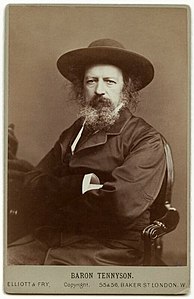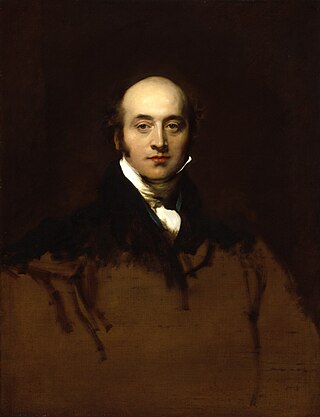
Sir Thomas Lawrence was an English portrait painter and the fourth president of the Royal Academy. A child prodigy, he was born in Bristol and began drawing in Devizes, where his father was an innkeeper at the Bear Hotel in the Market Square. At age ten, having moved to Bath, he was supporting his family with his pastel portraits. At 18, he went to London and soon established his reputation as a portrait painter in oils, receiving his first royal commission, a portrait of Queen Charlotte, in 1789. He stayed at the top of his profession until his death, aged 60, in 1830.

Sir Hubert von Herkomer was a Bavarian-born British painter, pioneering film-director, and composer. Though a very successful portrait artist, especially of men, he is mainly remembered for his earlier works that took a realistic approach to the conditions of life of the poor. Hard Times showing the distraught family of a travelling day-labourer at the side of a road, is one of his best-known works.

Alexander Bassano was an English photographer who was a leading royal and high society portrait photographer in Victorian London. He is known for his photo of the Earl Kitchener in the Lord Kitchener Wants You army recruitment poster during the First World War and his photographs of Queen Victoria.

John Jabez Edwin Paisley Mayall was an English photographer who in 1860 took the first carte-de-visite photographs of Queen Victoria. He is most well known for his 1875 portrait of Karl Marx.

Lucy Elizabeth Kemp-Welch was a British artist and teacher who specialized in painting horses. Though increasingly overlooked after the Second World War, from the late 1890s to the mid-1920s she was one of the country's best-known female artists. As her obituary in The Times noted, 'Like most artists who came to maturity and were established before the end of the nineteenth century, Lucy Kemp-Welch suffered somewhat in her later reputation from the violent changes in art which followed. In her prime as an animal painter she held a position in this country comparable to that of Rosa Bonheur in France, and the only British woman artist of her generation who was more talked about was Lady Elizabeth Butler, painter of "The Roll Call".' Her reputation has since revived, and she is best known today for her large paintings of wild and working horses in the New Forest, and those in military service which she produced during the First World War, as well as for her illustrations to the 1915 edition of Anna Sewell's novel Black Beauty.

Joseph William Comyns Carr, often referred to as J. Comyns Carr, was an English drama and art critic, gallery director, author, poet, playwright and theatre manager.
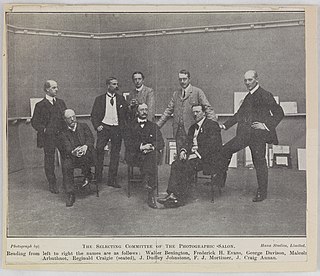
The Linked Ring was a British photographic society created to propose and defend photography as being just as much an art as it was a science. Members dedicated to the craft looked for new techniques that would cause the less knowledgeable to steer away, persuading photographers and enthusiasts to experiment with chemical processes, printing techniques and new styles.
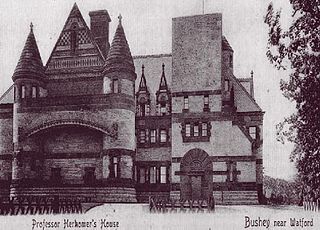
Lululaund was the Romanesque Revival-style house and studio of the Bavarian-born British artist Hubert von Herkomer, in Melbourne Road, Bushey, Hertfordshire. It was designed about 1886 and completed by 1894. The house was demolished in 1939.
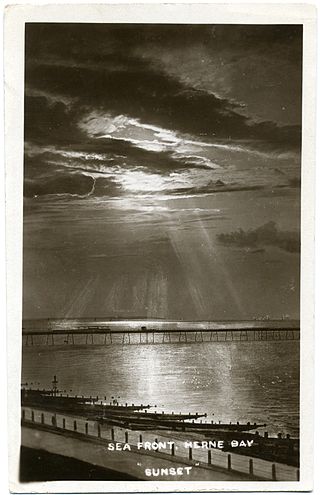
Frederick Christian Palmer, known professionally as Fred C. Palmer, was the main public photographer of Herne Bay, Kent in the early years of the 20th century, working from Tower Studio. He photographed all the civic events in Herne Bay before 1914, and made portraits of the eccentric Edmund Reid, the erstwhile head of Metropolitan Police Service CID who had investigated the Whitechapel murders and then retired to Hampton-on-Sea, Herne Bay. In 1913 Marcel Duchamp used Palmer's 1910 photograph of the illuminated Grand Pier Pavilion as found object art in his Note 78, part of his Green Box artwork. In the 1920s and early 30s, Palmer took over William Hooper's Cromwell Street studio in Swindon, again producing local postcards, photographing prominent people and doing freelance work for local newspapers and the council.

Walter Ernest Stoneman was an English portrait photographer who is known for taking photographs for the National Portrait Gallery (NPG) in London.

Henry Walter Barnett, usually known as H. Walter Barnett, was an Australian photographer and filmmaker. Barnett was a prominent portrait photographer of the late 19th and early 20th centuries, establishing the successful Falk studios in Sydney. Later in his career he was based in London, England, with studios at Hyde Park Corner and Knightsbridge. Barnett became involved in filmmaking after meeting cinematographer Marius Sestier in 1896, and with Sestier made some of the first films shot in Australia.

Daniel Albert Wehrschmidt, also known as D. A. Veresmith, was a German-American artist from Ohio who made a career for himself in England as a portrait painter, lithographer, and engraver.
Walter Benington (1872–1936) was a British photographer. Working in the Victorian era and the first half of the twentieth century, his important contribution to early twentieth century photography has been more fully recognised in the doctoral thesis of Robert Crow.

Helen Margaret Muspratt was a British photographer.

The Last Muster is an 1875 oil painting by Sir Hubert von Herkomer, based on his wood engraving Sunday at the Chelsea Hospital published in The Graphic on 18 February 1871. The painting is in the Lady Lever Art Gallery in Port Sunlight, Wirral.
Godfrey Thurston Hopkins (16 April 1913 – 27 October 2014), known as Thurston Hopkins, was a British Picture Post photojournalist and a centenarian.
George Garland (1900–1978) was a photographer known for his images of rural crafts and craftsmen taken in rural West Sussex.

William Silas Spanton was a British artist, art historian and photographer based in Bury St Edmunds in Suffolk.

Victorian headless portraits were a fad in Britain in the late 19th century. In the photographs, the model's head appears separated from the body; often the sitter holds it in their own hands. Although this genre is called headless portraiture, it is the head that is always present in the photograph, and the body may be absent.

Stuart Griffiths is a British photographer and writer living in Hastings, East Sussex. He published photographs from his time in the Parachute Regiment in The Myth of the Airborne Warrior (2011) and wrote about that period and later in Pigs' Disco (2013). Griffiths has had a solo exhibition, Closer, at MAC, Birmingham and his work is held in the collection of the Imperial War Museums.





